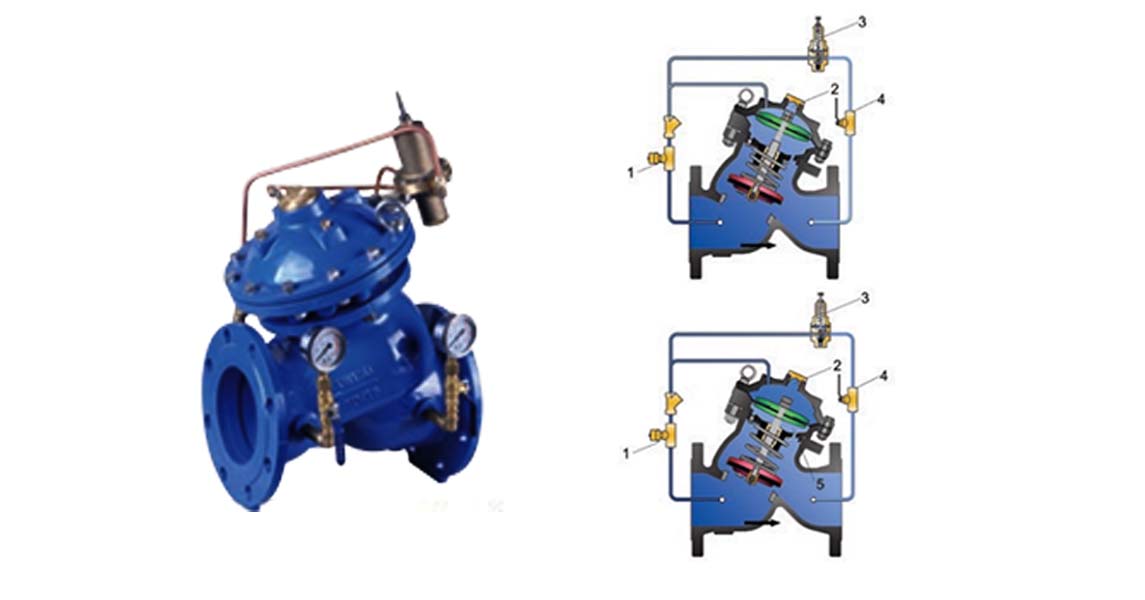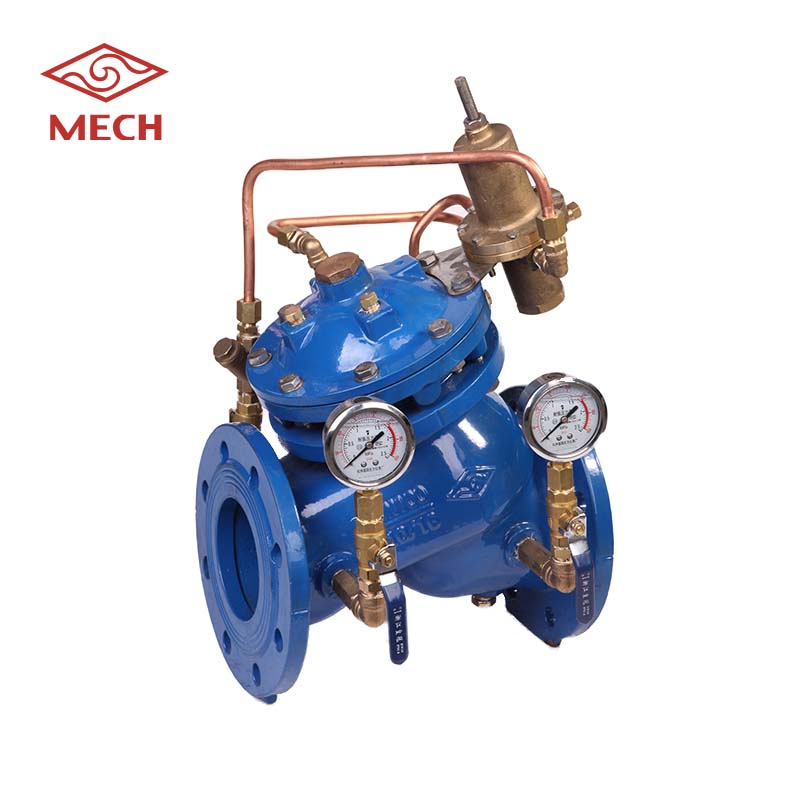
SK720X Pressure Reducing Valve is a diaphragm type of hydraulic control valve driven by the hydraulic pressure within the piping system. The function of the valve is to reduce the high pressure to the pre-set low pressure, and despite the fluctuation of medium flow or pressure before the valve the pressure after the valve will always remain stable and maintain the set pressure range.
◔Operational principle

SK720X Pressure Reducing Valve is controlled by pressure reducing pilot valve and equipped with pressure reducing pilot valve, needle valve, mini strainer and ball valve, etc.
Under normal conditions, water flow comes continuously from the inlet opening to the upper cavity room.
of the basic valve through the needle valve (1); When the pressure before the pilot valve (3) is lower than its pre-set value, the pilot valve will remain at full open position and the upper cavity room of the basic valve is not able to get accumulating pressure. Under this condition, the disc of the basic valve will be open at the water pressure from the inlet opening to allow water flow. The pressure reducing pilot valve closes gradually when the pressure after pilot valve exceeds its pre-set value. Pressure gets accumulated within the upper cavity room and membrane drives the disc down to close the valve till the pressure after the pilot valve gradually reduces to its pre-set value. The pilot valve opens again when the pressure after the valve becomes lower than the pre-set value, and the basic valve will then open with the release of the accumulated pressure in the upper cavity room.
The throttle orifice (5) that connects the lower cavity to the outlet serves to keep the reaction of the valve gentle and stable. The ball valve (4) controls the outlet water flow rate from the upper cavity room and thus to stabilize the action of the basic valve. The ball valve can be adjusted with different working conditions. In case of emergency, the ball valve can also be closed manually for cutting off of the basic valve.
◔ Property and advantages
• Driven by pressure of pipe system, work automatically with energy of pipe system to achieve energy conservation and environment protection.
• Controlled by the pilot valve, lower energy consumption, achieve accurate pressure reducing results, have function of stabilizing pressure after the valve.
• Dual cavity design, with functions of fully opening and fully closing. Slow shut causes no pressure fluctuation, and the diaphragm with support is well protected.
• Have internal orifice, connect bottom cavity and outlet of the basic valve, make sure stability of reaction to keep stability of pressure after the valve, avoid any vibration and noise.
• Channel with straight-flow, slight friction loss, no eddy flow and turbulent flow, cut down the damage of cavitation.
• Long pitch orientation design for stem move, stable and no gap resistance.
• Balanced automatically, big gap design on connection of disc and stem, disc is free on the vertical flat against stem, it can balance the tolerance from machining and sealing surface. Good connection without leakage. Achieve functions of both reducing dynamic pressure and reducing static pressure.
• Ductile iron castings with nodularity higher than 90%, foundry in house with advanced melting technology and strict quality control system, testing reports and testing bars can be supplied with order. Records and testing bars maintained for one year in the factory.
• Good corrosion resistance, with stainless steel, copper alloy, rubber made from DuPont and other rust- resisting material, fusion bonded epoxy coating both for interior and exterior surface of the basic valve. All the characteristics in accordance with ANSI/AWWA C550 and other international specifications like WRAS, NSF61.

Notes for installation and debugging
• All the Pressure Reducing Valves have been finished initial debugging tests before delivery. Further dubugging test is also suggested during using according to different working conditions. After the pipe system becomes stable, please loose the adjusting screw on the top of pilot valve to the top- most position.
• After the pipe system becomes stable, please loose the adjusting screw on the top of pilot valve to the top- most position.
• Tighten adjusting screw of pilot valve in clockwise slowly. When outlet pressure increase to the set pressure please fasten the locknut under the adjusting screw.
• If go beyond the set pressure during adjusting, please repeat the above steps. Remember, pressure can be only adjusting from low level to high level and pay attention to make the adjusting slowly.
Pressure | Symbol | Unit | Nominal Pressure | ||
|
|
| PN10 | PN16 | PN25 |
Max. Inlet pressure | P1max | MPa | 1.0 | 1.6 | 2.5 |
Min. Inlet pressure | P1min |
| P2max + 0.2 | ||
Max. Outlet pressure | P2max |
| 0.8 | 1.0 | 1.6 |
Min. Outlet pressure | P2min |
| 0.05 | ||
Characteristics of flow deviation | ΔP2Q |
| ≤10% | ||
Pressure characteristic deviation | ΔP2p |
| ≤5% | ||
Min. pressure deviation | ΔPmin |
| 0.2 | ||

Common Problems | Proposed Solutions |
Outlet pressure is similar with inlet pressure, no pressure reduction. | a.Check if any sundries on the sealing surface of basic valve or pilot valve. b.Check if any damage on the sealing surface of basic valve or pilot valve. c.Check if any damage or fatigue on spring of basic valve or pilot valve. d.Check if any damage or fatigue on diaphragm of basic valve or pilot valve. e.Check if any corrosion or blocking on stem of basic valve or pilot valve. |
Strong vibration and noise. | 1.Close the needle valve before the basic valve and open 1/4 turns slowly. Open the big hex screw on the top of bonnet, release air. Adjust the needle valve on inlet conduit slowly until no vibraion. 2.Calculate the flow again and collect proper size of valve or add throttling set. |
Pressure after the valve is not stable. | a.Check if pressure is fluctuating strongly at inlet. Try to keep it within small range. b.Check if required flow is too different than actual flow, recalculate flow and choose new valve with proper size. |
Copyright © 2021 Guangzhou Weyes Network Technology Co., Ltd. | All Rights Reserved